This blog is for primitive dog enthusiasts. It is part of the INDog Project www.indog.co.in. Only INDogs (India's primitive indigenous village dogs) and INDog-mixes (Indies) are featured here. The two are NOT the same, do please read the text on the right to understand the difference. Our aim: to create awareness about the primitive landrace village dog of the Indian subcontinent. I sometimes feature other landrace breeds too. Also see padsociety.org
Tuesday, August 31, 2010
Gujarati desert dogs play in South China Sea
More non-resident Indies! Lisa's Button and Penelope, litter mates, have emigrated to Vietnam and become real water babies. Join them for a fun minute as they romp on the beach. Their light build and shape remind me of Kimaya, though she's quite a bit smaller I think.
Video: Lisa Warden
Vietnam
The secret life of the Australian Dingo
One of my favourite canids is the Australian Dingo, Canis lupus dingo, introduced there from Asia by human settlers perhaps 5000 years ago.
Like many other canids (wolves, coyotes and domestic species like our very own free-ranging INDog), the dingo lives in a cloud of controversy in its own land - viewed by many as an iconic animal of Australia and by others as a menace to be exterminated.
Luckily these beautiful animals have some strong support. Research has thrown new light on their behaviour and exposed some commonly held beliefs as myths. Click here for an interesting TV interview from last year, in which researcher Dr Brad Purcell explains why human intervention in the dingo pack structure actually leads to increased livestock predation. There are parallels in other countries with other species: misguided and ignorant interference in animal populations does much more harm than good.
More on this research project here.
Australian Dingos featured in this blog in March last year. Click here to see some very handsome specimens in a snowy landscape! The pictures were sent to me by Julie Fechner of Dingo Care Network. Their site is very informative for anyone interested in this topic: http://www.dingo.org.au
Like many other canids (wolves, coyotes and domestic species like our very own free-ranging INDog), the dingo lives in a cloud of controversy in its own land - viewed by many as an iconic animal of Australia and by others as a menace to be exterminated.
Luckily these beautiful animals have some strong support. Research has thrown new light on their behaviour and exposed some commonly held beliefs as myths. Click here for an interesting TV interview from last year, in which researcher Dr Brad Purcell explains why human intervention in the dingo pack structure actually leads to increased livestock predation. There are parallels in other countries with other species: misguided and ignorant interference in animal populations does much more harm than good.
More on this research project here.
Australian Dingos featured in this blog in March last year. Click here to see some very handsome specimens in a snowy landscape! The pictures were sent to me by Julie Fechner of Dingo Care Network. Their site is very informative for anyone interested in this topic: http://www.dingo.org.au
Saturday, August 28, 2010
INDogs of central India
I clicked these pictures in the last two days, in a village on the periphery of Pench Tiger Reserve. The village is called Sawra.
I visit Sawra nearly every month on work, but the dogs aren't usually outdoors in the hotter part of the day, which typically is when I go there (in between wildlife safaris). Now however it's the height of the "mating season." Like some other aboriginal breeds and unlike modern breeds, INDogs have a seasonal breeding cycle. So the village dogs were much more active and visible than I've seen them so far.
About half of all village dogs I've seen in central Indian villages are INDog-mix, with deviations from the pariah morph such as completely dropped ears or long fur. I'm referring to villages in forest areas because those are the only ones I visit. Pench is not very far from the city of Nagpur, so that would explain mongrelization in village dogs of the area. However even in Melghat Tiger Reserve and deep inside the very remote Satpuda Tiger Reserve, I've seen many mix-breed dogs along with dogs of perfect INDog appearance. Here's my earlier post on dogs of the Satpudas. The villagers (mostly Gond and other tribals) must have brought in dogs of other breeds for some reason, most probably because they felt they would be good at hunting or guarding livestock.
INDogs in central India are often slightly bigger than the ones in eastern India (such as dogs of Bengal and Orissa).

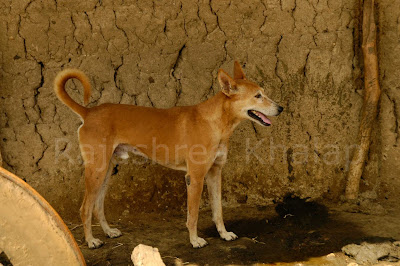



Above, below: This pale male was extremely busy wooing the canine village belles. I saw him many times in my two days there, as he trotted around on the important business of perpetuating his genes and ensuring the survival of his bloodline!
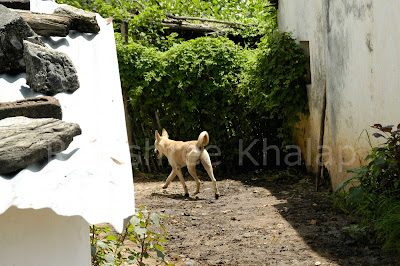
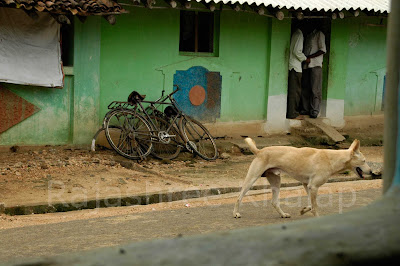

Above: One of the stops of the pale male. The black INDog-mix here is called Rani and belongs to this household. Somewhere in her ancestry there is probably a spitz, a very common pet breed in urban India and occasionally seen in rural India as well.
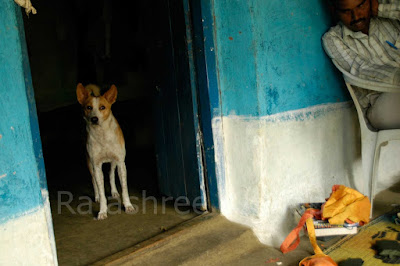
Above, below: This dog belongs to the family of Vaishali Kumre. They've never named him but he is treated with kindness and affection and sleeps inside the house. Gond tribals are fond of dogs. In fact most aboriginal people in India are respectful of them and allow them in the house, unlike "mainstream" Hindu villagers, who keep them as pets but usually on the porch or in the yard.
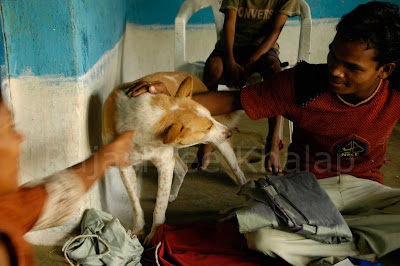
Above: Vaishali's dog is aloof with strangers and wasn't very comfortable with my attempts to photograph him. I've come across this suspicion of camera lenses in many village dogs across the country. I suppose the lens looks like a magnified stare to them and they don't know how to react, unlike our city pets who are accustomed to being being clicked every other day (I'm thinking of Lalee's complete boredom with our photo sessions). Here the dog was trying to sneak into the inner room without my noticing him. Vaishali and her friend tried to hold him still for the photo.

Above: As soon as he could, he ran off outside
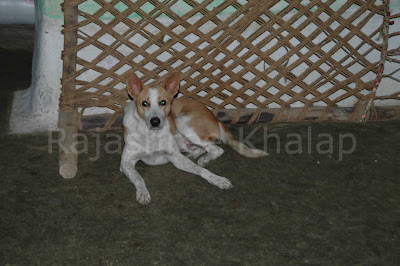
Above: Waking from a long siesta in the family bedroom

Above: This is one of the INDog-mix dogs I mentioned. Very handsome but quite large and with completely drooping ears.
Pench
Maharashtra
I visit Sawra nearly every month on work, but the dogs aren't usually outdoors in the hotter part of the day, which typically is when I go there (in between wildlife safaris). Now however it's the height of the "mating season." Like some other aboriginal breeds and unlike modern breeds, INDogs have a seasonal breeding cycle. So the village dogs were much more active and visible than I've seen them so far.
About half of all village dogs I've seen in central Indian villages are INDog-mix, with deviations from the pariah morph such as completely dropped ears or long fur. I'm referring to villages in forest areas because those are the only ones I visit. Pench is not very far from the city of Nagpur, so that would explain mongrelization in village dogs of the area. However even in Melghat Tiger Reserve and deep inside the very remote Satpuda Tiger Reserve, I've seen many mix-breed dogs along with dogs of perfect INDog appearance. Here's my earlier post on dogs of the Satpudas. The villagers (mostly Gond and other tribals) must have brought in dogs of other breeds for some reason, most probably because they felt they would be good at hunting or guarding livestock.
INDogs in central India are often slightly bigger than the ones in eastern India (such as dogs of Bengal and Orissa).

Above, below: This pale male was extremely busy wooing the canine village belles. I saw him many times in my two days there, as he trotted around on the important business of perpetuating his genes and ensuring the survival of his bloodline!

Above: One of the stops of the pale male. The black INDog-mix here is called Rani and belongs to this household. Somewhere in her ancestry there is probably a spitz, a very common pet breed in urban India and occasionally seen in rural India as well.
Above, below: This dog belongs to the family of Vaishali Kumre. They've never named him but he is treated with kindness and affection and sleeps inside the house. Gond tribals are fond of dogs. In fact most aboriginal people in India are respectful of them and allow them in the house, unlike "mainstream" Hindu villagers, who keep them as pets but usually on the porch or in the yard.
Above: Vaishali's dog is aloof with strangers and wasn't very comfortable with my attempts to photograph him. I've come across this suspicion of camera lenses in many village dogs across the country. I suppose the lens looks like a magnified stare to them and they don't know how to react, unlike our city pets who are accustomed to being being clicked every other day (I'm thinking of Lalee's complete boredom with our photo sessions). Here the dog was trying to sneak into the inner room without my noticing him. Vaishali and her friend tried to hold him still for the photo.

Above: As soon as he could, he ran off outside
Above: Waking from a long siesta in the family bedroom
Above: This is one of the INDog-mix dogs I mentioned. Very handsome but quite large and with completely drooping ears.
Pench
Maharashtra
Tuesday, August 24, 2010
Isipho, AfriCanis pup

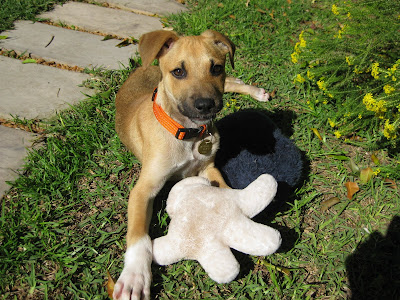






Meet the latest member of Yvonne's canine pack in Cape Town.
This beautiful pup is Isipho (pronounced eseepaw). His name is a Xhosa word meaning "gift." He's a typical native dog of the country, much as the Indian Pariah/INDog is here.
He was found scrounging on a garbage dump and was rescued by an organization called African Tails. Yvonne took him in and he has transformed from a scrawny malnourished little fellow into the handsome healthy boy you see in the last picture. Leela and Rishi are only too happy to have a new playmate and family member! Here they are all playing together.
Read more about the indigenous dogs of subequatorial Africa in this site.
Some earlier posts on Rishi and Leela: Sea Dogs, Rishi and Leela portraits, The Indi and the cat, Part 6, My Cape Town holiday with Rishi and Leela and The Burial,
Snapshots in the snow.
This is my post about Pariah dogs of Tanzania.
Photos: Yvonne de Kock
Cape Town
South Africa
African Tails is on Facebook.
Saturday, August 21, 2010
INDog on the beach
Tuesday, August 17, 2010
Lady and the Tramp, Part 2
Our friend Brownie is on the beach most evenings, and playing with him is the high point of Kimaya's day. He loves running and he also loves splashing in the sea, so they have a lot in common.
Brownie has an amazing gift for preventing and resolving conflicts. He does this more than any other dog I've ever met. Much of his behaviour reminds me of Turid Rugaas's wonderful little book "On talking terms with dogs" - here's my post about the book and this is her website. He adores Kimaya and is very protective of her. He prevents other dogs from coming too close to her by getting in between them. In fact he does this frequently with different dogs too. Watch him in this video, he breaks up potential conflicts several times - Dogwatching on the beach

Above, below: The brown INDog in these pictures is actually a friend of Brownie's but he was worried that the dog might harm Kimaya. He had been playing with him but when we arrived on the beach he stood between the INDog and Kimaya and barked till the INDog went away.


And then it's time for pushing and shoving and racing...

Below: Brownie and Lalee




Above: I've taught Brownie to "sit" for a biscuit like Kimaya and Lalee, but here he got a bit impatient!

When Lalee and I are in Nagaon, Brownie always comes home with us for dinner. After a meal and an hour's nap he's taken back to his own home by our caretaker. He's often a dinner guest at our house when Lalee and I aren't there too. Sometimes he accompanies Kimaya and our caretaker home from the beach, but sometimes he comes over by himself and whines at our gate to be let in. His manners are excellent and even that stern critic, Tabbyrani, approves of him and allows him to sniff her a little.
We've tried having him sleep over at our place, but he just can't bear to be locked into a room and soon after midnight starts scratching the door and trying to get out. So we thought it best to drop him back to his own place for the night. His family own a tourist lodge and a plantation with a fence all around, so Brownie can roam the grounds at night but he can't get out.
Earlier posts featuring Brownie:
Nagaon dogs: Brownie
Sun, wind, joy
Lady and the Tramp
Note: All the beach pictures in this post were taken with my phone, because it was raining intermittently and I didn't want my camera to get wet.
Nagaon
Brownie has an amazing gift for preventing and resolving conflicts. He does this more than any other dog I've ever met. Much of his behaviour reminds me of Turid Rugaas's wonderful little book "On talking terms with dogs" - here's my post about the book and this is her website. He adores Kimaya and is very protective of her. He prevents other dogs from coming too close to her by getting in between them. In fact he does this frequently with different dogs too. Watch him in this video, he breaks up potential conflicts several times - Dogwatching on the beach

Above, below: The brown INDog in these pictures is actually a friend of Brownie's but he was worried that the dog might harm Kimaya. He had been playing with him but when we arrived on the beach he stood between the INDog and Kimaya and barked till the INDog went away.


And then it's time for pushing and shoving and racing...

Below: Brownie and Lalee




Above: I've taught Brownie to "sit" for a biscuit like Kimaya and Lalee, but here he got a bit impatient!
When Lalee and I are in Nagaon, Brownie always comes home with us for dinner. After a meal and an hour's nap he's taken back to his own home by our caretaker. He's often a dinner guest at our house when Lalee and I aren't there too. Sometimes he accompanies Kimaya and our caretaker home from the beach, but sometimes he comes over by himself and whines at our gate to be let in. His manners are excellent and even that stern critic, Tabbyrani, approves of him and allows him to sniff her a little.
We've tried having him sleep over at our place, but he just can't bear to be locked into a room and soon after midnight starts scratching the door and trying to get out. So we thought it best to drop him back to his own place for the night. His family own a tourist lodge and a plantation with a fence all around, so Brownie can roam the grounds at night but he can't get out.
Earlier posts featuring Brownie:
Nagaon dogs: Brownie
Sun, wind, joy
Lady and the Tramp
Note: All the beach pictures in this post were taken with my phone, because it was raining intermittently and I didn't want my camera to get wet.
Nagaon
Spark Plug update

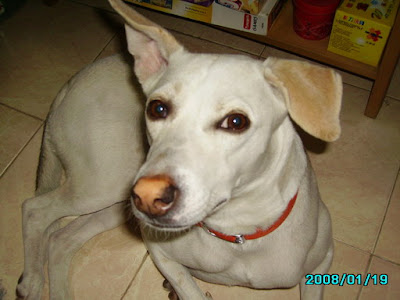

 Revisiting Spark Plug, who was featured in this blog nearly three years ago! Click here for his earlier post.
The first picture here is from his puppy days. Sparky was rescued from the vicinity of Mumbai airport in February 2005. He was the last surviving member of his litter. Malnourished, worm- ridden and traumatized, the first few weeks were touch-and-go.
"It took us a full year to sort out his worm problem but he was finally cured," writes owner Aarti Phatarphekar. "He is an unruly five-and-a-half year old, whom we just can't do without. My daughter Ria calls him her younger brother who doesn't talk! And the housekeeper actually thinks he is a god who has come to protect our family."
Sparky shifted to Hyderabad with Aarti and Ria a few years ago.
Photos: Aarti Phatarphekar
Hyderabad
Revisiting Spark Plug, who was featured in this blog nearly three years ago! Click here for his earlier post.
The first picture here is from his puppy days. Sparky was rescued from the vicinity of Mumbai airport in February 2005. He was the last surviving member of his litter. Malnourished, worm- ridden and traumatized, the first few weeks were touch-and-go.
"It took us a full year to sort out his worm problem but he was finally cured," writes owner Aarti Phatarphekar. "He is an unruly five-and-a-half year old, whom we just can't do without. My daughter Ria calls him her younger brother who doesn't talk! And the housekeeper actually thinks he is a god who has come to protect our family."
Sparky shifted to Hyderabad with Aarti and Ria a few years ago.
Photos: Aarti Phatarphekar
Hyderabad
Little dog on the shore

That's my pretty Kimaya wandering at the water's edge, and of course the Dog with the Doughnut Tail is Lalee.
I took these pictures a couple of days before the oil spill in Mumbai. The oil floated down the coast and in Nagaon people have been told not to catch or eat fish. Kimaya is not being taken to the beach at all for now, and we've warned the owners of our dog friend Brownie not to let him out either.
I wonder whether the oystercatchers, whimbrels, brahminy kites and magnificent white-bellied sea eagle are safe...they make the beach even more beautiful.
Nagaon
Monday, August 16, 2010
Cynophobia
Cynophobia = an abnormal or persistent fear of dogs. Derived from Greek kyon (dog) + phobos (fear).
I believe a large number of urban Indians suffer from some degree of cynophobia, though of course not all are extreme.
I am not referring to people who have a rational fear of dogs. I do myself under certain circumstances; and those who are not dog lovers would naturally be more scared than I am. I believe it's normal to step aside when an unknown dog passes you, specially if it is of formidable appearance. I also believe it's normal to feel nervous when walking past a pack of fighting snarling dogs. It's normal to feel alarmed if an unknown dog jumps on you. It's normal to be scared of dogs if you have ever been attacked or bitten by a dog, specially if you don't know why it happened.
But it is a phobia if you scream or jump at the sight of a dog that is not bothering you in any way. Or if you go to unnatural lengths to avoid proximity to dogs, OR if you go to extreme lengths to have perfectly inoffensive dogs removed from your neighbourhood.
I'm not trying to ridicule cynophobes here. I myself suffer from an irrational fear of some creepy-crawlies whose only fault is that they are ugly to the human eye. I know exactly how a phobia feels, and I sympathize. I have a few friends and acquaintances (just a few) who are cynophobic and freely admit it. They know and accept that most dogs may be harmless and that the problem is in their own mind. I like and respect these people for their honesty.
My complaint is against the kind of cynophobe who does not admit that she/he has a kind of disorder. Such people feel that their fear is rational. Worst of all, they very often try to justify their fear of a specific dog or dogs, by inventing stories of attacks and aggression. It's mostly men who do this, no doubt because they feel admitting to any kind of irrational fear would make them appear effeminate. (The same kind of men stamp on lizards and spiders, because they are deeply afraid of them...)
This kind of fear of dogs is so common in urban India that it isn't seen as abnormal at all. The dogs can't defend themselves against false accusations or exaggerations. So cynophobia claims many canine victims.
You'll rarely find a cynophobe in rural India though. Here's a picture of two Nagaon ladies who regularly walk on the beach. They probably pass this pack of dogs every day and pay no attention to them at all. They looked alarmed one evening when my Kimaya ran towards them, but they soon realized she was playing and smiled and went on their way.
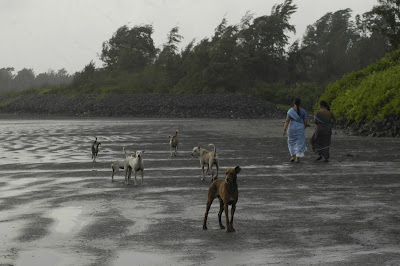
My second complaint against most cynophobes is that they don't make any attempt to cure the problem. How can you cure a problem if you won't even admit it exists?
Coming back to my phobia, I'm the conservative type and I think dramatic displays inappropriate in a woman of my age. When the insect I fear buzzes into view, I can now control myself to the extent that I won't make a scene in public. Though I'll definitely remove myself discreetly from its presence at the earliest opportunity!
It took me time and effort to reach this level of self-control. Why can't others make the same effort to overcome their fear of dogs, mice, snakes, bats, lizards, owls, cats...? I have some of my neighbours in mind as I write this: elderly women who scream, jump up and down flailing their arms and generally behave like caricatures if they happen to be in the elevator when I try to enter with my dogs. My nickname for them is "the screamers."
Needless to say, the lift men, all of rural origin, hide big grins when these circuses take place. And I politely wait for the next elevator.
I believe a large number of urban Indians suffer from some degree of cynophobia, though of course not all are extreme.
I am not referring to people who have a rational fear of dogs. I do myself under certain circumstances; and those who are not dog lovers would naturally be more scared than I am. I believe it's normal to step aside when an unknown dog passes you, specially if it is of formidable appearance. I also believe it's normal to feel nervous when walking past a pack of fighting snarling dogs. It's normal to feel alarmed if an unknown dog jumps on you. It's normal to be scared of dogs if you have ever been attacked or bitten by a dog, specially if you don't know why it happened.
But it is a phobia if you scream or jump at the sight of a dog that is not bothering you in any way. Or if you go to unnatural lengths to avoid proximity to dogs, OR if you go to extreme lengths to have perfectly inoffensive dogs removed from your neighbourhood.
I'm not trying to ridicule cynophobes here. I myself suffer from an irrational fear of some creepy-crawlies whose only fault is that they are ugly to the human eye. I know exactly how a phobia feels, and I sympathize. I have a few friends and acquaintances (just a few) who are cynophobic and freely admit it. They know and accept that most dogs may be harmless and that the problem is in their own mind. I like and respect these people for their honesty.
My complaint is against the kind of cynophobe who does not admit that she/he has a kind of disorder. Such people feel that their fear is rational. Worst of all, they very often try to justify their fear of a specific dog or dogs, by inventing stories of attacks and aggression. It's mostly men who do this, no doubt because they feel admitting to any kind of irrational fear would make them appear effeminate. (The same kind of men stamp on lizards and spiders, because they are deeply afraid of them...)
This kind of fear of dogs is so common in urban India that it isn't seen as abnormal at all. The dogs can't defend themselves against false accusations or exaggerations. So cynophobia claims many canine victims.
You'll rarely find a cynophobe in rural India though. Here's a picture of two Nagaon ladies who regularly walk on the beach. They probably pass this pack of dogs every day and pay no attention to them at all. They looked alarmed one evening when my Kimaya ran towards them, but they soon realized she was playing and smiled and went on their way.
My second complaint against most cynophobes is that they don't make any attempt to cure the problem. How can you cure a problem if you won't even admit it exists?
Coming back to my phobia, I'm the conservative type and I think dramatic displays inappropriate in a woman of my age. When the insect I fear buzzes into view, I can now control myself to the extent that I won't make a scene in public. Though I'll definitely remove myself discreetly from its presence at the earliest opportunity!
It took me time and effort to reach this level of self-control. Why can't others make the same effort to overcome their fear of dogs, mice, snakes, bats, lizards, owls, cats...? I have some of my neighbours in mind as I write this: elderly women who scream, jump up and down flailing their arms and generally behave like caricatures if they happen to be in the elevator when I try to enter with my dogs. My nickname for them is "the screamers."
Needless to say, the lift men, all of rural origin, hide big grins when these circuses take place. And I politely wait for the next elevator.
Thursday, August 12, 2010
Sammy

I was always a dog lover but my parents denied me the pleasure of being a dog owner all through my growing up years. I used to bring in INDog pups and beg Ma to let me keep them, but to no avail. As I grew older, my love for dogs became restricted to petting friendly street dogs or feeding them biscuits. After finishing college, I got busy with the mundane and INDogs took a backseat.
One fine winter afternoon, my husband and I decided to visit the Garden of Five Senses in Mehrauli. I had never been to the park though it was so close to my house, and my mood needed some cheering after a really awful week at work. When our trip was about to end and we reached an auditorium-like space, my eye caught sight of a pup that was coming down a rocky slope with his tail wagging. He looked happy to see me, as if we were long-lost friends. I had seen many pups before, INDog and otherwise, but never had I come across such an adorable doll.
Above: First picture of him ever!
I took an instant liking to him as I picked him up. One striking thing about him was his expressions. He was making such adorably cute faces as if conveying, "What is this girl getting so excited about me for?"
He was all by himself, no other pups around. After a few minutes of us taking pictures and videos of him, his mother came around. He went to her with his tiny tail wagging but she turned away. For us that was it. That was the moment when we decided to take him along with us.
The key issues remained, as I lived in a paying guest accommodation and my husband was sharing a room with his friends. There was nowhere we could keep him except for my mother's. Going by past experiences, Ma was sure to turn him down but I couldn't leave him there to die in the cold. By the way, did I mention that he was nice and fat? He was round and looked so cute when he walked on his tiny legs.
Another point to be noted is that he didn't need any rescuing. He seemed fine and happy in his natural habitat, his birthplace. The sole reason for picking him up was that he was simply too adorable to let go and now I can say, because it was meant to happen!
I put him inside my jacket and we drove 30 odd kilometers on a bike, with him sleeping on my thigh, to where my parents live. The minute she opened the door and saw him in my arms, her first reaction was "Oh my god he's so sweet," followed by a practical "Why did you bring him here?" The most beautiful thing that we recall now is the amazing comfort level this worried (judging by his expression) pup felt when he entered my mom's place. He started running around, met Ma and jumped into and slept in her lap. We were both astonished to see him transform himself with the confidence of someone in his own home.
Above: First meeting with Ma
Below: First nap at home
We named him Sam which has now become Sammy.
The next day we took him for his vaccinations, deworming and so on. A friend gave her little daughter's sweater for Sammy to wear, which you can see in his pictures.



Above: With his favourite toy in his tub
Below: Sammy likes the camera

All this was January 2008 and he was about 5 to 6 weeks old when I found him. Today he's become the light of our home.

Above: After some mischief
What is phenomenal is my mother's transformation from being neutral to dogs to someone who cannot be away from Sammy for a minute. He's the apple of her eye and she dotes on him unconditionally. Ma had never raised a pup before but we all learned as we went along.
Now two and a half years have passed and life without him is unimaginable; we sometimes wonder why we deprived ourselves of this love so long.

Above: Winter mood

We have never treated him as being any different from us. He is the son of the family and like a kid, he is never chained, even if there are guests at home, or prohibited from entering certain areas or sitting anywhere. He is extremely friendly and welcomes everyone inside our home. He then sits on people's feet to prevent them from getting out of the house!

When we brought him home, we didn't even think about the fact that he was an Indian dog. He was just an adorable pup who deserved to be with us, for our own selfish reasons of enjoying his cuteness. Now people ask us what breed he is.

Sammy is a wonderful gift of God. Like all INDogs, he is intelligent, healthy, affectionate and just as deserving of a loving home as any other dog in the world. We're lucky to have him and hope that many other families get to experience the joy that an INDog can bring into their lives.
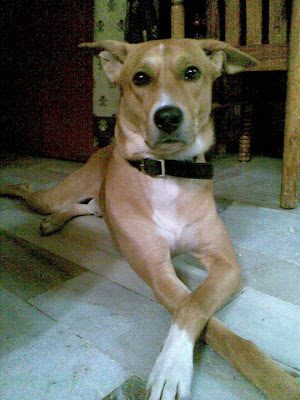
Above: Favourite pose
Sammy has changed all of us in ways that only we know. I have become more kind and patient. He communicates so much even without speaking that it is simply amazing to see how identical he is in feeling things, expressions and reactions, to us. His unconditional love has changed our lives and made us understand the real meaning of a dog's company: one which is full of love and lots of laughter.

Story and photos: Juhee Dubey
Delhi
Subscribe to:
Posts (Atom)



